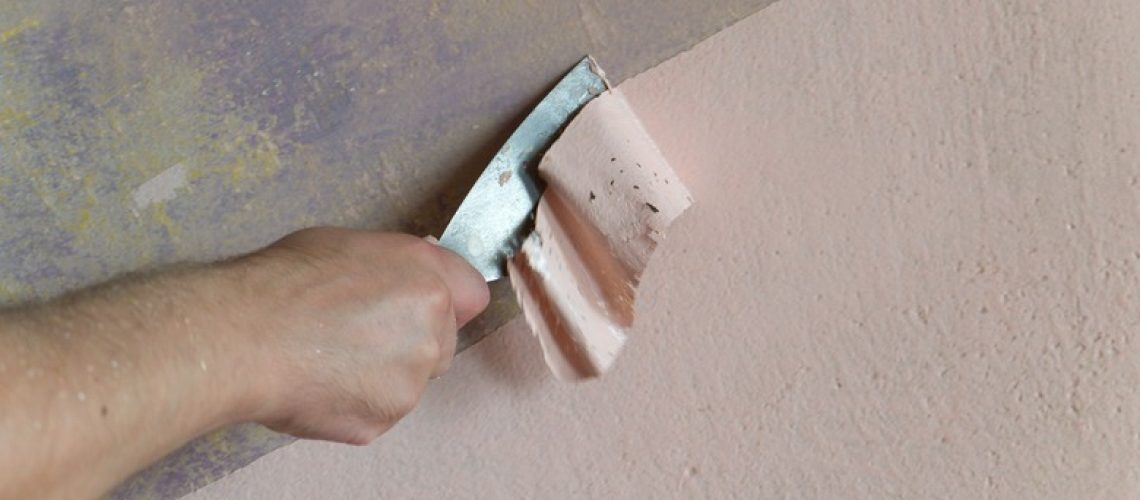- Removing paint stains from concrete is viable although it’s often seen as very difficult.
- There are many ways to remove paint from concrete surfaces, with acetone, pressure washing, and grinding being the easiest and most effective.
- People who prefer non-toxic DIY alternatives can use hot vinegar, hot water + dish soap, and boiling water + baking soda to scrap off paint from concrete.
- To prevent future pain stains, it’s best to seal the surface with a regular sealer, sealer, a polyaspartic coating, or a polished concrete finish.
Painting concrete patios, block walls, or basement floors is a common practice for transforming the dull grey surface into one worth admiring. However, accidental spills can ruin the clean, polished look of your new paint job.
You might be wondering, “Can I successfully remove paint from concrete without calling a professional service?” Yes, you can!
It may not be the easiest thing to do, but it’s not impossible either. In this guide, we show you how to get paint off concrete without much trouble.
Common Issues Encountered When Removing Paint From Concrete
Removing paint from concrete can be hard and time-consuming. Specific issues may also arise depending on the type of paint, the age of the paint stain, and the method used.

Concrete damage is one of the most common issues associated with stripping paint from concrete. Cracks, breaks, chipped pieces, or pits on the underlying layer are caused by improper handling of the pressure washer and concrete grinder.
Excess dust and mess are also common, no matter which concrete paint stripper you’re using.
Lastly, there is always a risk of toxicity when using a paint stripper for concrete, especially one containing methylene chloride. This harmful chemical can be inhaled or absorbed through the skin, which puts you and everyone around you at risk.
Why Is Paint Removal From Concrete a Tricky Task?
Removing paint from concrete is tricky because concrete is a porous material. As such, it can absorb liquids and semi-liquids, like paint, immediately.
Also, the paint is saturated on the surface, so it doesn’t get off easily. The only way to do it is by resurfacing the area, which is tedious.
And there’s always a chance of future staining if the concrete isn’t sealed. The only way to prevent this is by sealing the freshly cleaned area.
Easy and Effective Methods for Paint Removal
A lot of people wonder how to remove paint from concrete easily. Well, there’s no magic wand to make the paint stains disappear. However, there are several easy and effective methods for paint removal:
Method 1: Acetone for a Hassle-Free Paint Removal Experience
Acetone is a powerful solvent that can easily remove paint stains from concrete surfaces. It’s most effective for removing acrylic, oil-based, and enamel paints. Below, we’ll explain how you can use acetone for paint removal on concrete:
How Can I Use Acetone to Remove Paint From Concrete Step-by-Step?
Using acetone as a paint stripper for concrete allows you to get rid of paint stains on your patio, garage floor, and any other concrete effectively. To use this method, follow these steps:
- Wash the area you want to clean with a bucket of warm water or a hose and let it dry.
- Soak a rag in the acetone and place it over the painted area. It will prevent the acetone from spreading around the surface and absorb it completely, which doesn’t occur when pouring acetone directly on the affected area.
- Wait for 20 minutes for the acetone to absorb the paint.
- Scrub the area with warm soapy water and a stiff-bristled brush.
- Rinse the area with a bucket of water or a hose.
What Materials Do I Need, and What Safety Precautions Should I Take?
Apart from acetone, you also need:
- Bucket with warm water or hose
- Eye protection, i.e., goggles
- Gloves
- Respiratory mask
- Stiff-bristled brush.
Acetone is a highly potent and toxic solvent, and as such, it can irritate your eyes, airways, and skin. That’s why it’s crucial to wear protective gear during the entire paint-stripping process right after you wash the surface.
Method 2: Pressure Washing for Quick and Efficient Paint Removal

Pressure washing is the simplest and most natural, chemical-free method for removing paint from concrete. It doesn’t require any special equipment and it’s mostly effective on fresh, wet paint on an outdoor concrete surface:
How Does Pressure Washing Effectively Remove Paint From Concrete?
If you’ve been thinking about how to remove paint from concrete safely, pressure washing is the answer. It uses a narrow stream of water running at a high pressure of at least 3,000 psi to effectively remove the paint stains without damaging the surface.
When the stream hits the affected area, it enters the concrete’s capillary pores, eliminating the stain. For best results, pour boiling water over the paint stain and cover it with a rag or a towel to absorb it before pressure washing.
What Equipment Is Necessary for Safe Pressure Washing?
Knowing how to get paint off of concrete properly is important to protect yourself during the process. To keep yourself safe, you need the following gear:
- A cold water pressure washer – since professional hot water pressure washers are quite expensive.
- A nozzle between 10-25 degrees.
- Towel or rag
- Protective gear
- Plastic sheeting – to protect the surrounding areas and objects from getting all wet.
Method 3: Grinding for Stubborn Paint Stains

Stubborn paint stains are the hardest to remove, especially if they’re old. If you’ve been looking at how to get paint off concrete effectively, grinding may just be the solution.
How Does Grinding Tackle Tough Paint Stains on Concrete?
Grinders are perfect for stripping paint from concrete. They completely grind off the layer of paint stain using a diamond-impregnated disc, not leaving a single dot on the surface.
Tips for Using a Grinder and Staying Safe During the Process
Grinding guarantees complete paint stain removal as it cuts off the upper layer of the surface. However, its power is what makes this paint remover for concrete highly risky. That’s why it’s vital to know how to use it properly.
Here are several tips to help you with that:
- Choose a handheld grinder for cleaning a smaller area or a larger push-along model for a bigger area.
- Move the grinder back and forth constantly across the surface to prevent deep indentions and holes in it.
- Use water during the grinding process to reduce the dust released and protect the diamond disc.
- Wear protective gear during the process.
- Rinse or vacuum the surface at the end to remove the dust and clean the area of debris.
Alternative Approaches for Paint Removal
Finding the right method for removing paint from concrete can be somewhat difficult. There are many options available, from baking soda and vinegar to chemical paint strippers.
Let’s explore possible alternatives to see which one would work best for you:
Can I Use DIY Paint Strippers or Eco-Friendly Options to Remove Paint?
Of course. Eco-friendly concrete paint stripper solutions prepared at home can be equally or more effective than store-bought chemical ones. They are easy to prepare because they use household products commonly found at home.
Some of the best non-toxic alternatives include hot vinegar, dish soap + hot water, boiling water + baking soda, citrus-based cleaners, and soy-based gel paint strippers.
What Are Soda Blasting And Power Washing, and How Do They Help with Paint Removal?
Soda blasting is an effective, safe, and eco-friendly method of removing paint from concrete. It uses compressed air that blasts baking soda particles and water solution onto the blemished surface.
Power washing is quite similar to soda blasting, but instead of soda bicarbonate, it uses plain water as a cleaner. A water stream at high-pressure levels is released from the power washer to eliminate paint from concrete. It’s safe and eco-friendly and doesn’t damage the affected surface.
Both methods are effective in eliminating paint blemishes on concrete as they use a focused water stream at a high-pressure rate. Of course, their efficacy may differ based on the type of paint and how old it is, with old stains being the hardest to remove.
Preventing Future Paint Stains on Concrete
The best way to prevent future paint stains on concrete is by sealing the surface. Sealing is an easy process that involves applying a protective coat over the concrete, preventing moisture to get to it and into it.
You can use a classic sealer, a polyaspartic coating, or a polished concrete finish. All of these options prevent moisture from getting to the concrete in one way or another. Classic sealers, for instance, make the concrete non-porous, whereas the two types of finishes serve as an insulation layer.
Conclusion
That concludes our guide on how to remove paint from concrete. Removing paint stains from concrete can be pretty hard, especially if they’ve been there for years. But it doesn’t have to be if you employ the right concrete paint removers.
There are many options to choose from, from acetone and grinding to pressure washing and baking soda with boiling water. When choosing which paint remover to use, consider the type of paint and how long it’s been on the concrete because not all cleaners have the same effect on all paint stains.
FAQs About Removing Paint from Concrete
Is paint stripper toxic, and what safety precautions should I follow?
Chemical-based paint strippers, like the ones containing methylene chloride, are highly toxic. They contain dangerous chemicals that cause irritations to the skin, eyes, and respiratory system, headaches, dizziness, and even more serious health issues.
What impact does paint stripper have on underlying concrete and existing stains?
Paint strippers are effective in removing paint stains on concrete. However, they can affect the underlying concrete differently.
Natural, eco-friendly paint strippers are gentle on the surface and clean the layer beneath. Chemical-based paint removers, on the other hand, are harsh and can damage the underlying concrete, causing discolorations and indentions.
However, if the paint stripper is used properly, there shouldn’t be any damage.
Can I apply new paint over existing paint as an alternative solution?
It’s not recommended to apply new paint over an existing paint stain because the surface needs to be clean and smooth for the paint to adhere. If you paint over the affected area, the result will be an unevenly colored, eyesore-causing surface.





